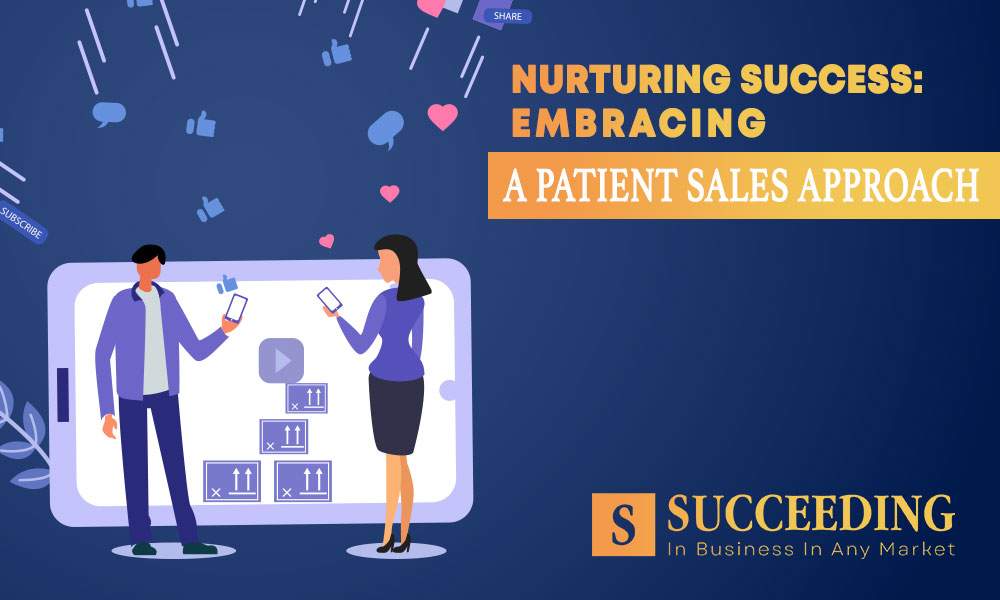In the ever-evolving landscape of sales, the importance of building trust and fostering long-term customer relationships cannot be overstated. A key element in achieving this lies in adopting a patient sales approach. This article delves into the nuances of patient selling, emphasizing the adverse effects of pressure in sales and providing actionable strategies for implementing a more sustainable and relationship-focused approach. Welcome to the world of patient sales, where success is nurtured through understanding and respecting the customer’s journey.
1: The Pitfalls of Pressure in Sales
1.1 Understanding the Negative Impact:
In the pursuit of short-term gains, applying pressure in sales can lead to detrimental consequences. Customer distrust, dissatisfaction, and a damaged reputation are just a few of the potential pitfalls. We’ll explore how high-pressure tactics can result in lost opportunities and hinder the development of lasting customer relationships.
1.2 Common Pressure Tactics to Avoid:
Identifying and steering clear of common pressure tactics is essential for ethical sales practices. This section will shed light on tactics like aggressive deadlines, pushy sales pitches, and manipulative techniques. Recognizing these tactics will empower sales professionals to pivot towards a more transparent and customer-centric approach.
2: The Essence of a Patient Sales Approach
2.1 Defining the Patient Sales Approach:
What does it mean to embrace a patient sales approach? At its core, patience in sales involves understanding the customer’s timeline and respecting their decision-making process. We’ll delve into how this approach aligns with the shift towards customer-centric, consultative selling, where relationships take precedence over quick transactions.
2.2 Building Trust through Patience:
Trust is the cornerstone of any successful business relationship. This section explores how a patient sales approach is instrumental in building and maintaining trust with customers. Transparent communication and setting realistic expectations play a pivotal role in fostering trust, with real-world examples illustrating the effectiveness of this approach.
3: Strategies for Implementing a Patient Sales Approach
3.1 Active Listening and Understanding Customer Needs:
Active listening is a key component of patient selling. By honing the skill of active listening, sales professionals can gain deeper insights into customer needs. This section provides practical tips for active listening and highlights its role in tailoring patient sales strategies to meet individual customer requirements.
3.2 Setting Realistic Expectations:
Setting realistic expectations is crucial in a patient sales approach. We’ll discuss the significance of transparent communication regarding timelines and outcomes, helping alleviate customer concerns and preventing disappointments. Successful businesses manage expectations effectively, and we’ll explore how you can do the same.
4: Overcoming Challenges in Patient Selling
4.1 Balancing Patience and Achieving Sales Targets:
A common concern is the balance between a patient approach and meeting sales targets. This section addresses the challenge, providing strategies for setting realistic sales goals without resorting to high-pressure tactics. Success stories will showcase businesses that have achieved remarkable success through a patient approach.
4.2 Handling Customer Impatience:
Customers may also exhibit impatience, adding another layer to the challenge. This section provides strategies for sales professionals to handle customer impatience with professionalism and empathy. Through examples, we’ll demonstrate how businesses turned challenging situations into opportunities for customer satisfaction.

Conclusion:
In the fast-paced realm of sales, a patient approach emerges not as a hindrance but as a sustainable and effective strategy. By understanding the pitfalls of pressure and embracing patience, businesses can foster trust, build lasting relationships, and ultimately achieve sales success that stands the test of time.
Reflect on your current sales strategies and consider how a more patient approach could benefit your business. Share your experiences and insights into the benefits of patient selling with your peers and mentors.
FAQs:
Q1: Can a patient sales approach be effective in meeting short-term sales goals?
A1: Yes, a patient sales approach can be effective in meeting short-term sales goals. While it may take longer to cultivate relationships, the trust built through patience often leads to more consistent and sustainable sales over time.
Q2: How can sales professionals balance a patient approach with the need to meet sales targets quickly?
A2: Balancing a patient approach with the need for quick results involves setting realistic sales goals, focusing on relationship-building, and leveraging strategic opportunities. It requires a shift from immediate transactions to long-term customer value.
Q3: How do you handle impatience from customers in a patient sales approach?
A3: Handling customer impatience involves empathetic communication, setting clear expectations, and demonstrating the long-term benefits of a patient approach. Businesses can turn impatience into an opportunity for educating customers about the value of their products or services.
Q4: Is a patient sales approach suitable for all industries or specific to certain products/services?
A4: A patient sales approach is adaptable and can be effective across various industries. While the nuances may differ, the fundamental principles of building relationships, understanding customer needs, and transparent communication are universally applicable.
Q5: Can a patient sales approach work in a highly competitive market?
A5: Yes, a patient sales approach can thrive in a competitive market. Building trust and lasting relationships can be a unique selling proposition in itself. By providing value, understanding customer needs, and demonstrating patience, businesses can stand out even in highly competitive environments.




